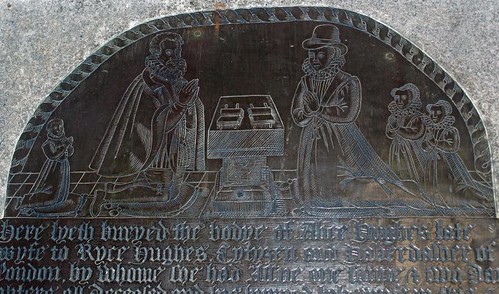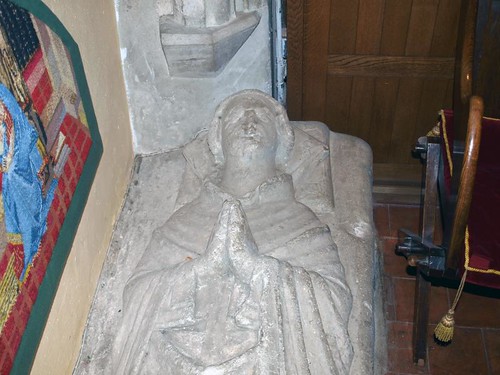ST IPPOLYTS. On an eminence above the houses of the village. Rebuilt in 1879 with careful re-use of the old materials. Low W tower with much set-off angle buttresses. Nave and aisles with gabled N porch with decorated outer doorway (niches to 1. and r. and above) and S porch of brick and timber. Windows in the chancel and S aisle and a doorway in the N aisle are clearly of the early C14 (see the Dec window). The nave arcades belong to the same date. They are cut into a much older wall and have double-chamfered arches. The inner voussoirs rest on remarkable broad-faced, broad-haired C14 heads. The chancel arch is C15, but the Piscina shows that the S wall at least must be E.E. - SCREEN. Only bits are old. - PLATE. Chalice, 1634; Paten, 1639. - MONUMENTS. Brass of 1594 with small kneeling figures (chancel). - Effigy of a priest, C14 (recess in S aisle).
Ippollitts. Everyone must wonder at its curious name, which is said to be explained by the church on the top of the hill, one of only two in England dedicated to St Hippolytus. He was a 3rd-century martyr and a doctor of horses, and the story goes that sick horses were led into this village church in the hope of a miraculous cure. Most of the church, with its little lead-covered spire, is 14th century, but part of an early Norman window and an arch carved by the earliest English builders are left where the arcades were cut in the old nave walls. It was in the 14th century that this was done, when the stone figure of a priest was laid in a recess. The timbers of the south porch are 15th century, and the central arch of the chancel screen is from the same time. From the 16th century are the brass portraits of Ryce and Alice Hughes, with their three children all kneeling in handsome Elizabethan dress. Some of the old corbels remain with new ones keeping them company, and the old font is in use after 700 years. A lady of our own day, Anne Fletcher, is remembered by a bright window picturing Dorcas with some poor cottagers. A few hundred yards to the south of the village is a little hamlet called Red Coats Green, to which Charles Dickens and 12,000 other people made pilgrimage last century with the morbid desire of seeing a poor madman called Lucas the Hermit. Dickens told his story in All the Year Round, but it is a pitiful tale of one who in these days is taken care of instead of being made a public curiosity and it is better forgotten.
At Ippollitts in 1941 they laid to rest Lord Lloyd, one of the most vigorous of our empire statesmen, a fearless soldier and wise administrator, with a wide experience of the East.
At Ippollitts in 1941 they laid to rest Lord Lloyd, one of the most vigorous of our empire statesmen, a fearless soldier and wise administrator, with a wide experience of the East.


No comments:
Post a Comment